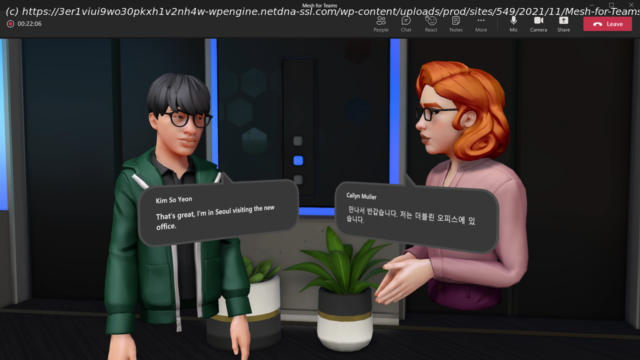Mesh for Teams is designed to make online meetings more personal, engaging and fun.
More than a year and a half into a global pandemic that forced workers around the world to abandon their offices and learn to collaborate online, Microsoft productivity experts have observed two trends: remote workers are far more efficient than most business leaders ever imagined, and they miss each other. They miss hallway moments, kitchen catch-ups and chance encounters. They miss the body language from across the conference room table that says things that can’t be said. In other words, the ability to work from anywhere and connect with colleagues online is awesome, but remote meetings can feel impersonal and lack the small moments that build relationships and careers. Ongoing studies in Microsoft’s research organization prove this out: people feel more present and engaged in meetings when everyone turns on their video cameras, for example. But the video option can be awkward and binary – on or off. Too many people, too much of the time, are a static picture or bubble with initials. Microsoft today has unveiled a solution to this problem that begins rolling out in 2022: Mesh for Microsoft Teams. The feature combines the mixed-reality capabilities of Microsoft Mesh, which allows people in different physical locations to join collaborative and shared holographic experiences, with the productivity tools of Microsoft Teams, where people can join virtual meetings, send chats, collaborate on shared documents and more. Mesh builds on existing Teams features such as Together mode and Presenter mode that make remote and hybrid meetings more collaborative and immersive, according to Jeff Teper, a Microsoft corporate vice president whose responsibilities include the Microsoft 365 productivity tools Teams, SharePoint and OneDrive. These tools are all ways “to signal we’re in the same virtual space, we’re one team, we’re one group, and help take the formality down a peg and the engagement up a peg,” Teper said. “We’ve seen that those tools have accomplished both goals of helping a team be more effective and also helping individuals be more engaged.” Mesh for Teams – which anyone will be able to access from standard smartphones and laptops to mixed-reality headsets – is designed to make online meetings more personal, engaging and fun. It’s also a gateway to the metaverse – a persistent digital world that is inhabited by digital twins of people, places and things. Think of the metaverse as a new version – or a new vision – of the internet, one where people gather to communicate, collaborate and share with personal virtual presence on any device. The first step most users of Mesh for Teams will take is to join a standard Teams meeting as a customized avatar of themselves instead of as a static picture or on video. Organizations can also build immersive spaces – metaverses – within Teams. Mesh for Teams users can take their avatars into these spaces to mix and mingle, collaborate on projects and experience those serendipitous encounters that spark innovation. “Welcome to Mesh for Teams,” said Microsoft Technical Fellow Alex Kipman. “As a company whose focus is on productivity, on knowledge workers, it’s something that customers are really asking us for, and it’s coupled with the vision of mixed reality that we’ve been working on for 12 years. It’s all coming together.” Kipman and his team have spent several years building Mesh-enabled immersive spaces with global professional services company Accenture, which has more than 600,000 people serving clients all over the world. Before the pandemic, for example, Accenture built a virtual campus where employees from anywhere could gather for coffees, presentations, parties and other events. “We started to call it the Nth Floor, this magical, mythical campus that could only be found in virtual reality,” said Jason Warnke, senior managing director and global digital experiences lead for Accenture. His favorite feature, he added, is the ability to bump into colleagues from around the world and have deep and meaningful conversations. Jazzed after each event, he’d have ideas for five more.
Home
United States
USA — software Mesh for Microsoft Teams aims to make collaboration in the ‘metaverse’ personal...






